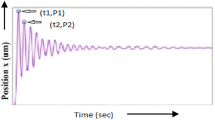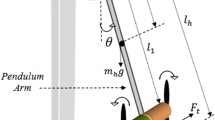Abstract
This paper focuses on the application of a novel inverse nonlinear autoregressive with exogenous input (NARX) structure and a fuzzy inference system on position control of a piezo positioning stage (PPS) system. The highly relationship between input voltage and output displacement is thoroughly modeled by using the inverse fuzzy NARX model-based identification process with the experiment training data. The unknown parameters of the proposed NARX fuzzy model was obtained base on a hybridization between backtracking search algorithm and gradient descent technique. A combination between fuzzy propositional–integral–derivative controller and inverse modeling feedforward controller was then applied to control PPS with several challenged working condition. The results show efficiency of the proposed method for the PPS system in terms of high tracking precision and excellent dynamic performance.
Similar content being viewed by others
References
D. Croft, G. Shedd and S. Devasia, Creep, hysteresis, and vibration compensation for piezoactuators: Atomic force microscopy application, Proceedings of the 2000 American Control Conference, ACC (IEEE Cat. No. 00CH36334) (2000).
P. J. M. Michael and A. Paesler, Near–field optics: Theory, instrumentation, and applications, John Wiley, Newyork (1996).
A. J. Fleming and S. O. R. Moheimani, Sensorless vibration suppression and scan compensation for piezoelectric tube nanopositioners, IEEE Transactions on Control Systems Technology, 14 (1) (2006) 33–44.
C. J. Lin and S. R. Yang, Precise positioning of piezoactuated stages using hysteresis–observer based control, Mechatronics, 16 (7) (2006) 417–426.
H. J. Shieh and P. K. Huang, Trajectory tracking of piezo–electric positioning stages using a dynamic sliding–mode control, IEEE Transactions on Ultrasonics, Ferroelectrics, and Frequency Control, 53 (10) (2006) 1872–1882.
D. Huang, J. X. Xu, V. Venkataramanan and T. C. T. Huynh, High–performance tracking of piezoelectric positioning stage using current–cycle iterative learning control with gain scheduling, IEEE Transactions on Industrial Electronics, 61 (2) (2014) 1085–1098.
R. Xu and M. Zhou, Sliding mode control with sigmoid function for the motion tracking control of the piezoactuated stages, Electronics Letters, 53 (2) (2017) 75–77.
T. X. Dinh and K. K. Ahn, Radial basis function neural network based adaptive fast nonsingular terminal sliding mode controller for piezo positioning stage, International Journal of Control, Automation and Systems, 15 (6) (2017) 2892–2905.
T. X. Dinh and K. K. Ahn, Adaptive–gain fast nonsingular terminal sliding mode for position control of a piezo positioning stage, Proceedings of the Institution of Mechanical Engineers, Part I: Journal of Systems and Control Engineering (2018).
J. Lin, H. Chiang and C. C. Lin, Tuning PID control parameters for micro–piezo–stage by using grey relational analysis, Expert Systems with Applications, 38 (11) (2011) 13924–13932.
A. Sebastian and S. M. Salapaka, Design methodologies for robust nano–positioning, IEEE Transactions on Control Systems Technology, 13 (6) (2005) 868–876.
C. Chang–Qing and S. Ya–Peng, Optimal control of active structures with piezoelectric modal sensors and actuators, Smart Materials and Structures, 6 (4) (1997) 403.
Y. Wu and Q. Zou, Iterative control approach to compensate for both the hysteresis and the dynamics effects of piezo actuators, IEEE Transactions on Control Systems Technology, 15 (5) (2007) 936–944.
J. X. Xu, D. Huang, V. Venkataramanan and T. C. T. Huynh, Extreme precise motion tracking of piezoelectric positioning stage using sampled–data iterative learning control, IEEE Transactions on Control Systems Technology, 21 (4) (2013) 1432–1439.
P. K. Huang, P. H. Shieh, F. J. Lin and H. J. Shieh, Slidingmode control for a two–dimensional piezo–positioning stage, IET Control Theory & Applications, 1 (4) (2007) 1104–1113.
X. Chen and T. Hisayama, Adaptive sliding–mode position control for piezo–actuated stage, IEEE Transactions on Industrial Electronics, 55 (11) (2008) 3927–3934.
F. J. Lin, P. H. Shieh and P. H. Chou, Robust adaptive backstepping motion control of linear ultrasonic motors using fuzzy neural network, IEEE Transactions on Fuzzy Systems, 16 (3) (2008) 676–692.
F. J. Lin, S. Y. Lee and P. H. Chou, Intelligent nonsingular terminal sliding–mode control using MIMO elman neural network for piezo–flexural nanopositioning stage, IEEE Transactions on Ultrasonics, Ferroelectrics, and Frequency Control, 59 (12) (2012) 2716–2730.
J. Yi, S. Chang and Y. Shen, Disturbance–observer–based hysteresis compensation for piezoelectric actuators, IEEE/ASME Transactions on Mechatronics, 14 (4) (2009) 456–464.
B. N. M. Truong and K. K. Ahn, Inverse modeling and control of a dielectric electro–active polymer smart actuator, Sensors and Actuators A: Physical, 229 (2015) 118–127.
D. N. C. Nam and K. K. Ahn, Identification of an ionic polymer metal composite actuator employing Preisach type fuzzy NARX model and particle swarm optimization, Sensors and Actuators A: Physical, 183 (2012) 105–114.
K. K. Ahn and H. P. H. Anh, Inverse double NARX fuzzy modeling for system identification, IEEE/ASME Transactions on Mechatronics, 15 (1) (2010) 136–148.
B. N. M. Truong, D. N. C. Nam and K. K. Ahn, Hysteresis modeling and identification of a dielectric electro–active polymer actuator using an APSO–based nonlinear Preisach NARX fuzzy model, Smart Materials and Structures, 22 (2013) 095004.
K. K. Ahn and T. D. C. Thanh, Nonlinear PID control to improve the control performance of the pneumatic artificial muscle manipulator using neural network, Journal of Mechanical Science and Technology, 19 (9) (2005) 106–115.
S. Rajendiran and P. Lakshmi, Simulation of PID and fuzzy logic controller for integrated seat suspension of a quarter car with driver model for different road profiles, Journal of Mechanical Science and Technology, 30 (10) (2016) 4565–4570.
A. Şumnu, İ. H. Güzelbey and M. V. Çakir, Simulation and PID control of a Stewart platform with linear motor, Journal of Mechanical Science and Technology, 31 (1) (2017) 345–356.
G. H. Jun and K. K. Ahn, Extended–state–observer–based nonlinear servo control of an electro–hydrostatic actuator, Journal of Drive and Control, 14 (4) (2017) 61–70.
T. W. Ha et al., Position control of an electro–hydrostatic rotary actuator using adaptive PID control, Journal of Drive and Control, 14 (4) (2017) 37–44.
H. P. H. Anh and K. K. Ahn, Hybrid control of a pneumatic artificial muscle (PAM) robot arm using an inverse NARX fuzzy model, Engineering Applications of Artificial Intelligence, 24 (4) (2011) 697–716.
S. A. Billings, Nonlinear system identification: NARMAX methods in the time, frequency, and spatio–temporal domains, John Wiley & Sons (2013).
F. Cheong and R. Lai, Constraining the optimization of a fuzzy logic controller using an enhanced genetic algorithm, Trans. Sys. Man Cyber. Part B, 30 (1) (2000) 31–46.
P. Y. Jun, C. H. Suck and ·C. D. Hyuk, Genetic algorithmbased optimization of fuzzy logic controller using characteristic parameters, IEEE International Conference on Evolutionary Computation (1995).
P. Civicioglu, Backtracking search optimization algorithm for numerical optimization problems, Applied Mathematics and Computation, 219 (15) (2013) 8121–8144.
M. Boerlage, M. Steinbuch, P. Lambrechts and M. V. D. Wal, Model–based feedforward for motion systems, Proceedings of 2003 IEEE Conference on Control Applications (2003).
K. K. Ahn and D. Q. Truong, Online tuning fuzzy PID controller using robust extended Kalman filter, Journal of Process Control, 19 (6) (2009) 1011–1023.
Author information
Authors and Affiliations
Corresponding author
Additional information
Recommended by Associate Editor Yang Shi
To Xuan Dinh received the B.S. degree from the Department of Mechanical Engineering, Le Quy Don Technical University, Hanoi, Vietnam, in 2013. He is currently studying Integrated Course at University of Ulsan. His research interests focus on intelligent control, nonlinear control, optimization algorithm, design and control of smart actuators/materials, drone control and application.
Nguyen Phi Luan received his B.S. from Ho Chi Minh City University of Technology, Viet Nam, in 2010, and Ph.D. from University of Ulsan, Korea, in 2014. From 2014 to 2016, he was a researcher at University of Ulsan. He is currently an assistant manager at TRobotics Co., Ltd. Korea. His research interests include robotics, vision based automated system, automated guided vehicle (AGV).
Kyoung Kwan Ahn received the B.S. degree from the Department of Mechanical Engineering, Seoul National University, Seoul, Korea, in 1990, the M.Sc. degree in mechanical engineering from the Korea Advanced Institute of Science and Technology (KAIST), Daejeon, Korea, in 1992, and the Ph.D. degree from the Tokyo Institute of Technology, Tokyo, Japan, in 1999. He is currently a Professor in the School of Mechanical Engineering, University of Ulsan, Ulsan, Korea. His research interests include design and control of smart actuators using smart materials, fluid power control, and active damping control. Prof. Ahn is a member of the American Society of Mechanical Engineers (ASME), Society of Instrument and Control Engineers (SICE), Robotics Society of Japan (RSJ), Japan Society of Mechanical Engineers (JSME), Korean Society of Mechanical Engineers (KSME), Korean Society of Precision Engineers (KSPE), Korean Society of Automotive Engineers (KSAE), Korea Fluid Power Systems Society (KFPS), and Japan Fluid Power System Society (JFPS).
Rights and permissions
About this article
Cite this article
Dinh, T.X., Luan, N.P. & Ahn, K.K. A novel inverse modeling control for piezo positioning stage. J Mech Sci Technol 32, 5875–5888 (2018). https://doi.org/10.1007/s12206-018-1136-2
Received:
Revised:
Accepted:
Published:
Issue Date:
DOI: https://doi.org/10.1007/s12206-018-1136-2




